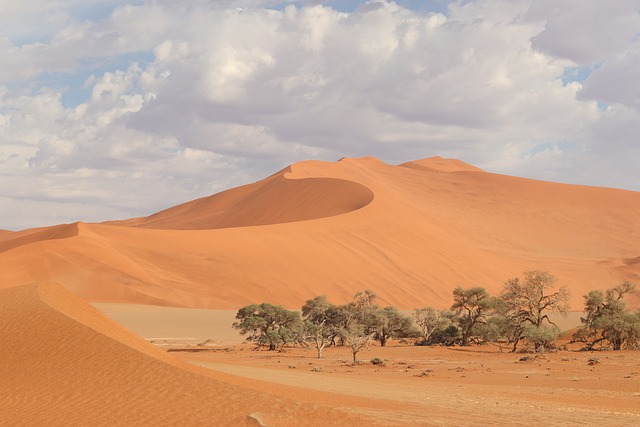
Sossusvlei, located in the southern part of the Namib Desert in Namibia, is one of the most captivating destinations in the world. Known for its towering red sand dunes, some of the highest on the planet, and its otherworldly landscapes, Sossusvlei offers a unique and breathtaking experience for travelers. This guide delves into the allure of Sossusvlei, its natural wonders, and practical information for making the most of your visit to this stunning part of Namibia.
Introduction to Sossusvlei
Sossusvlei is a salt and clay pan surrounded by high red dunes, situated in the Namib-Naukluft National Park. The name “Sossusvlei” roughly translates to “dead-end marsh,” indicating its status as an endorheic drainage basin that only fills with water in exceptional rainy seasons. This rare phenomenon transforms the area into a temporary lake, creating a striking contrast with the arid environment.
The Iconic Red Dunes
Dune 45
Dune 45 is one of the most photographed and accessible dunes in Sossusvlei. Standing at about 170 meters tall, it offers a relatively easy climb for visitors looking to experience the sunrise or sunset from its summit. The dune’s name comes from its location, 45 kilometers from the Sesriem gate.
Big Daddy
Big Daddy is the tallest dune in Sossusvlei, reaching approximately 325 meters in height. Climbing Big Daddy is more challenging, but the panoramic views from the top, overlooking Deadvlei and the surrounding desert, are immensely rewarding. The descent down the slipface is an exhilarating experience.
Deadvlei
Deadvlei is a stark white clay pan located near Sossusvlei, known for its petrified camelthorn trees, which stand in stark contrast against the white pan floor and the red dunes. The trees are estimated to be around 900 years old, and their eerie, skeletal appearance creates an iconic and hauntingly beautiful landscape.
Sesriem Canyon
Sesriem Canyon, located near the entrance to Sossusvlei, is a natural canyon carved by the Tsauchab River over millions of years. The canyon is about a kilometer long and up to 30 meters deep in some places. It offers a cool respite from the desert heat and provides insight into the geological history of the region.
Wildlife and Flora
Despite its harsh environment, Sossusvlei is home to a variety of wildlife adapted to the arid conditions. Visitors might spot oryx, springbok, and ostriches. Smaller creatures like geckos, beetles, and lizards are also common. The flora is primarily composed of hardy, drought-resistant plants like camelthorn trees, which have adapted to survive in the extreme desert conditions.
Activities and Experiences
Hot Air Ballooning
Hot air ballooning over Sossusvlei provides a bird’s-eye view of the vast desert landscape, offering an unparalleled perspective of the dunes and the surrounding area. Flights typically take place at sunrise, adding to the magical experience.
Guided Tours
Guided tours, both by vehicle and on foot, are an excellent way to explore Sossusvlei. Knowledgeable guides provide insights into the region’s geology, ecology, and history, enhancing the overall experience. Many tours include visits to Deadvlei, Big Daddy, and other key sites.
Photography
Sossusvlei is a paradise for photographers. The contrast between the red dunes, the white clay pans, and the deep blue sky provides striking visual opportunities. Early morning and late afternoon are the best times for photography, as the low-angle light enhances the colors and shadows.
Practical Information
Getting There
Sossusvlei is accessible by road from Windhoek, Namibia’s capital, a journey of about 350 kilometers. The drive takes approximately 5-6 hours. Alternatively, charter flights are available to the nearby airstrips for those looking for a quicker and more scenic arrival.
Accommodation
There are various accommodation options near Sossusvlei, ranging from luxury lodges to campsites. Notable lodges include Sossusvlei Lodge, Kulala Desert Lodge, and Little Kulala. These lodges offer comfortable amenities, guided tours, and spectacular views of the desert landscape.
Best Time to Visit
The best time to visit Sossusvlei is during the cooler months from May to September. Temperatures are more manageable, and the skies are generally clear. Visiting during the early morning or late afternoon is recommended to avoid the midday heat and to capture the best light for photography.
Permits and Fees
Entry to Sossusvlei requires a permit, which can be obtained at the Sesriem gate. The permit fees contribute to the maintenance and conservation of the Namib-Naukluft National Park. It’s advisable to carry cash for the permit fees, as card facilities may not always be available.
Conservation Efforts
The Namib-Naukluft National Park, including Sossusvlei, is a protected area aimed at preserving the unique desert ecosystem and its biodiversity. Conservation efforts focus on minimizing human impact, protecting wildlife habitats, and promoting sustainable tourism. Visitors are encouraged to follow guidelines, stay on designated paths, and respect the natural environment.
Conclusion
Sossusvlei, with its majestic red dunes, stark landscapes, and unique natural beauty, is a must-visit destination for anyone traveling to Namibia. Whether you’re drawn to the challenge of climbing the towering dunes, the eerie beauty of Deadvlei, or the serene experience of a hot air balloon ride over the desert, Sossusvlei offers an unforgettable adventure. Plan your visit to this extraordinary part of the world and immerse yourself in the timeless beauty of Sossusvlei, where nature’s artistry is on full display.